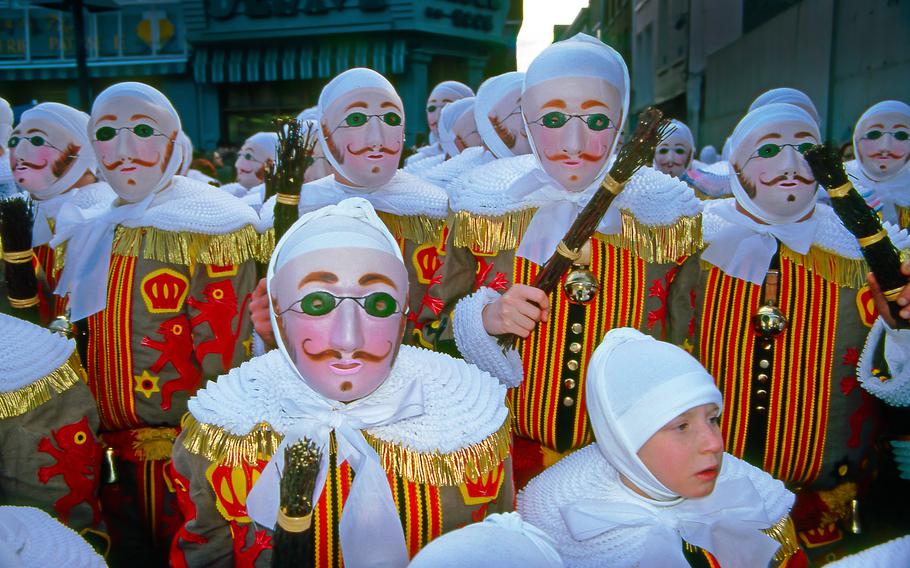
Gilles in masks dance through the streets each year in Binche, Belgium, on Shrove Tuesday. This year, that’s Feb. 13. (iStock)
Ask a kid to name his or her favorite holidays, and there’s a good chance Halloween will come out near or at the top of the list. And what’s not to love about a date that promises the chance to dress up like a cartoon hero or fairy-tale princess AND collect a bagful of candy? Small wonder, then, that Fasching, Fasnacht, Carnival or the myriad other names it goes by is so enduringly popular among youngsters. And when the grownups also dress up and get into the act, you’ve got a day out that can’t help but make a big impression. To see a child’s eyes grow a mile wide, consider attending one of these events:
Children’s parades: Many German carnival stronghold cities hold events specifically geared toward children. Mainz, Germany, is the site of what’s billed as Europe’s largest child and youth parade, which sets forth from the city center at 2:11 p.m. on Feb. 10. Duesseldorf also stages a child and youth parade that begins at the Goerres-Gymnasium at 2 p.m. on Feb. 10 and winds up at the Burgplatz. Children in Wiesbaden will converge upon Luisenplatz from 3:33 p.m. on Feb. 10. The parade concludes with the traditional storming of the Rathaus, or City Hall. Aachen’s youth will set off from Oppenhoffallee at 11:11 a.m. on Feb. 11.
Free candy! As those riding on board carnival floats throw candies and other trinkets in the direction of the spectators lining the streets, minor melees ensue as kids scramble to pick up whatever treats they can lay their hands on. These parades include the following events scheduled for Feb. 11: (from 11:55 a.m. in Wuerzburg; from 12:11 p.m. in Wiesbaden); Rose Monday, Feb. 12: (from 10 a.m. in Cologne; from 11:11 a.m. in Aachen; from 11:11 a.m. in Mainz; from 1:11 p.m. in Ludwigshafen) or Feb. 13: (from 2:11 p.m. in Heidelberg).
Burning effigies: Many celebrations conclude by burning an effigy symbolizing the excesses of all the festivities that came before. In the suburbs of Cologne, Germany— namely Nippes, Ehrenfeld and Muelheim — the last day of carnival (Feb. 13) includes the burning of the Nubbel, a scarecrow-like figure built of straw, in front of local pubs and other public spaces. Online: koeln.de/karneval/veilchendienstag-koeln
International Kid’s carnival: In Venice, Italy, the folks behind the Biennale di Venezia work hard to ensure kids are included in the carnival festivities held throughout the month of February. Through Feb. 11, children and their elders can enjoy theater workshops and more at the city’s Teatro Piccolo Arsenale and Ca’ Giustinian-San Marco, as well as at the Parco Albenese, Bissuola in Mestre. Preregistration is required and can be done online at labiennale.org.
Boat races: The city of Schramberg, Germany, celebrates its carnival with a type of crazy boat race known as the Da-Bach-Na-Fahrt. At 1 p.m. on Rose Monday, Feb. 12, 40 or so decorated two-man craft will take to the waters of a stream known as the Bach Berneck, their mission to navigate a 500-meter section of the waterway in the fastest time possible without going overboard. The purchase of an armband is the key to admission, and will also get one into the carnival parade immediately following. Online: bach-na-fahrt.de
A thousand identically dressed marchers: The carnival in Binche, Belgium, stars some of carnival’s strangest personalities, namely the Gilles. On Shrove Tuesday, Feb. 13, men wearing straw-padded red, black and yellow suits and white bow-tie collars, wax masks with glasses drawn on and wooden clogs will clomp and dance to the sound of a drum, waving sticks to ward off evil spirits as they go. On their second round through town, they’ll be wearing hats adorned with ostrich feathers and carry baskets of oranges which they toss, sometimes a bit too energetically, toward the spectators. It’s considered bad form and bad luck to toss the citrus back their way. Online: tinyurl.com/za3uhmcn
A massive food fight: Oranges also play a central role in the carnival of Ivrea, a city in northern Italy. The carnival’s origins are steeped in a legend that recounts the rape of a miller’s daughter by a tyrant of noble lineage on the eve of her wedding. After the young lady managed to cut his head off, an affronted populace stormed the palace and burned it to the ground. This liberation is commemorated by means of the Battle of the Oranges, in which teams of orange throwers on foot take on those positioned in carts. Tourists can also get in on the act by joining one of the nine combat teams. The battles take place at 2 p.m. on Feb. 11, 12 and 13. Online: storicocarnevaleivrea.it
Fool’s jump: The Black Forest town of Rottweil, Germany, adheres to an age-old tradition known as the Narrensprung, or Fools Jump. In their traditional dress of shirt, sash and gloves of white bedecked with colorful capes and bells, these figures wearing carved wooden masks passed down through the generations carry poles that serve as pogo sticks of sorts, allowing them to jump and cavort to the delight of the gathered crowds. The Narrensprung takes place at 8 a.m. on Feb. 12 and at 8 a.m. and 2 p.m. on Feb. 13. Tickets are necessary; these go for 10 euros adults and 5 euros for children. Online: narrenzunft-rottweil.de